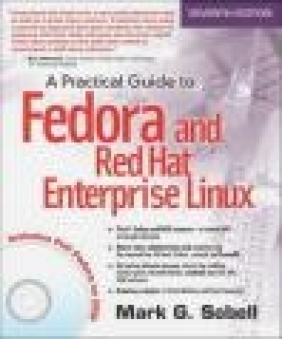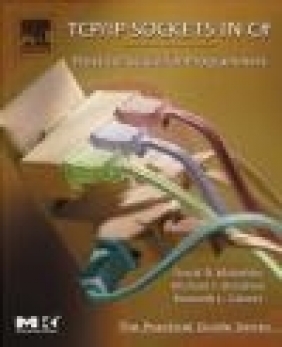A Practical Guide to Fedora and Red Hat Enterprise Linux
A Practical Guide to Fedora and Red Hat Enterprise Linux
- Producent: Prentice Hall
- Rok produkcji: 2013
- ISBN: 9780133477436
- Ilość stron: 1300
Niedostępna
Opis: A Practical Guide to Fedora and Red Hat Enterprise Linux
"I have found this book to be a very useful classroom text, as well as a great Linux resource. It teaches Linux using a ground-up approach that gives students the chance to progress with their skills and grow into the Linux world. I have often pointed to this book when asked to recommend a solid Linux reference." - Eric Hartwell, Chair, School of Information Technology, ITT Technical Institute Master All the Techniques You Need to Succeed with Fedora(TM) or Red Hat(R) Enterprise Linux(R) * The #1 Fedora and RHEL resource-a tutorial AND on-the-job reference * Master Linux administration and security using the command line, GUI tools, Python, systemd, and firewalld * Set up key Internet servers, step by step, including Samba, Apache, MariaDB/MySQL, sendmail, OpenSSH, DNS, LDAP, and more * Brand-new chapter on Virtual Machines and Cloud Computing! In this comprehensive guide, one of the world's leading Linux experts brings together all the knowledge and real-world insights you need to master and succeed with today's versions of Fedora or Red Hat Enterprise Linux. Best-selling author Mark Sobell explains Linux clearly and effectively, focusing on skills you'll actually need as a user, programmer, or administrator. Sobell assumes no prior Linux knowledge. He starts at the beginning and walks you through every topic and task that matters, using easy-to-understand examples. Step by step, you'll learn how to install and configure Linux from the accompanying DVD, navigate its graphical user interface, provide file/printer sharing, configure network servers, secure Linux desktops and networks, work with the command line, administer Linux efficiently, and automate administration using Python and bash. Mark Sobell has taught hundreds of thousands of Linux and UNIX professionals. He knows every Linux nook and cranny-and he never forgets what it's like to be new to Linux. Whatever you want to do with Linux-now or in the future-you'll find it in this book. Compared with other Linux books, A Practical Guide to Fedora(TM)and Red Hat(R)Enterprise Linux (R), Seventh Edition, delivers * Complete, up-to-the-minute coverage of Fedora 19 and RHEL 7 (beta) * New programming chapters that cover Python and MariaDB/MySQL, plus a new tutorial on using GnuPG to encrypt communications * Information on state-of-the-art security: SELinux, ACLs, firewalld (firewall-config and firewall-cmd), iptables (system-config-firewall), GnuPG, and OpenSSH * New chapter on VMs (virtual machines) and cloud computing, including VMware, QEMU/KVM, virt-manager, virsh, GNOME Boxes, and AWS (Amazon Web Services) * Expanded command-line coverage, including a new chapter that details 32 important utilities * Practical information on Internet server configuration, including Apache, sendmail, NFSv4, DNS/BIND, the new LDAP Dynamic Server, and IPv6 * Complete "meat-and-potatoes" information on system/network administration, now including GRUB 2, the XFS filesystem, the new Anaconda Installer, the systemd init daemon, firewalld, and NetworkManager * Detailed instructions on keeping Linux systems up to date, finding software packages, and working with repositories using yum and rpm * Full coverage of the LPI Linux Essentials exam objectives plus extensive coverage of the CompTIA Linux+ exam objectives; Appendix E provides a map from objectives to pages in the book * New coverage of find, sort, xz (compression), free, xargs, and the nano editor * And much more, including a 500+ term glossary and comprehensive indexes Includes DVD! Get the full version of the Fedora 19 release! Praise for Previous Editions of A Practical Guide to Fedora(TM) and Red Hat(R) Enterprise Linux(R) "Since I'm in an educational environment, I found the content of Sobell's book to be right on target and very helpful for anyone managing Linux in the enterprise. His style of writing is very clear. He builds up to the chapter exercises, which I find to be relevant to real-world scenarios a user or admin would encounter. An IT/IS student would find this book a valuable complement to their education. The vast amount of information is extremely well balanced and Sobell manages to present the content without complicated asides and meandering prose. This is a 'must have' for anyone managing Linux systems in a networked environment or anyone running a Linux server. I would also highly recommend it to an experienced computer user who is moving to the Linux platform." -Mary Norbury, IT Director, Barbara Davis Center, University of Colorado at Denver, from a review posted on slashdot.org "I had the chance to use your UNIX books when I when was in college years ago at Cal Poly, San Luis Obispo, CA. I have to say that your books are among the best! They're quality books that teach the theoretical aspects and applications of the operating system." -Benton Chan, IS Engineer "The book has more than lived up to my expectations from the many reviews I read, even though it targets FC2. I have found something very rare with your book: It doesn't read like the standard technical text, it reads more like a story. It's a pleasure to read and hard to put down. Did I say that?! :-)" -David Hopkins, Business Process Architect "Thanks for your work and for the book you wrote. There are really few books that can help people to become more efficient administrators of different workstations. We hope (in Russia) that you will continue bringing us a new level of understanding of Linux/UNIX systems." -Anton Petukhov "Mark Sobell has written a book as approachable as it is authoritative." -Jeffrey Bianchine, Advocate, Author, Journalist "Excellent reference book, well suited for the sysadmin of a Linux cluster, or the owner of a PC contemplating installing a recent stable Linux. Don't be put off by the daunting heft of the book. Sobell has striven to be as inclusive as possible, in trying to anticipate your system administration needs." -Wes Boudville, Inventor "A Practical Guide to Red Hat(R) Linux(R) is a brilliant book. Thank you, Mark Sobell." -C. Pozrikidis, University of California at San Diego "This book presents the best overview of the Linux operating system that I have found... [It] should be very helpful and understandable no matter what the reader's background: traditional UNIX user, new Linux devotee, or even Windows user. Each topic is presented in a clear, complete fashion and very few assumptions are made about what the reader knows... The book is extremely useful as a reference, as it contains a 70-page glossary of terms and is very well indexed. It is organized in such a way that the reader can focus on simple tasks without having to wade through more advanced topics until they are ready." -Cam Marshall, Marshall Information Service LLC, Member of Front Range UNIX Users Group [FRUUG], Boulder, Colorado "Conclusively, this is THE book to get if you are a new Linux user and you just got into RH/Fedora world. There's no other book that discusses so many different topics and in such depth." -Eugenia Loli-Queru, Editor in Chief, OSNews.com Praise for Other Books by Mark G. Sobell "This book is a very useful tool for anyone who wants to 'look under the hood' so to speak, and really start putting the power of Linux to work. What I find particularly frustrating about man pages is that they never include examples. Sobell, on the other hand, outlines very clearly what the command does and then gives several common, easy-to-understand examples that make it a breeze to start shell programming on one's own. As with Sobell's other works, this is simple, straightforward, and easy to read. It's a great book and will stay on the shelf at easy arm's reach for a long time." -Ray Bartlett, Travel Writer "Overall I found this book to be quite excellent, and it has earned a spot on the very front of my bookshelf. It covers the real 'guts' of Linux-the command line and its utilities-and does so very well. Its strongest points are the outstanding use of examplPreface xliii Chapter 1: Welcome to Linux 1 The History of UNIX and GNU-Linux 2 Overview of Linux 11 Choosing an Operating System 19 Chapter Summary 21 Exercises 21 Part I: Installing Fedora and Red Hat Enterprise Linux 23 Chapter 2: Installation Overview 25 Conventions Used in This Book 26 LPI and CompTIA Certification Icons 28 More Information 28 Planning the Installation 29 The Installation Process 44 Downloading an Installation Image File and Writing to/Burning the Installation Medium 46 Gathering Information About the System 50 Chapter Summary 52 Exercises 53 Advanced Exercises 53 Chapter 3: Step-by-Step Installation 55 The New Anaconda Installer 56 Running a Fedora Live Session 56 Installing Fedora/RHEL 59 Installation Tasks 69 Chapter Summary 86 Exercises 86 Advanced Exercises 86 Part II: Using Fedora and Red Hat Enterprise Linux 87 Chapter 4: Introduction to Fedora and Red Hat Enterprise Linux 89 Curbing Your Power (Superuser/root Privileges) 90 Logging In on the System 90 The GNOME 3 Standard and Classic Desktops 91 Working with the Desktop 97 Using the Nautilus File Manager 102 The Settings Window 107 Getting Help 113 Updating, Installing, and Removing Software Packages 116 Working from the Command Line 119 More About Logging In and Passwords 135 Chapter Summary 138 Exercises 139 Advanced Exercises 140 Chapter 5: The Shell 141 Special Characters 142 Ordinary Files and Directory Files 143 The Command Line 144 Standard Input and Standard Output 151 Running a Command in the Background 163 Filename Generation/Pathname Expansion 165 Builtins 170 Chapter Summary 170 Exercises 171 Advanced Exercises 173 Chapter 6: The Linux Filesystem 175 The Hierarchical Filesystem 176 Ordinary Files and Directory Files 177 Pathnames 181 Working with Directories 183 Access Permissions 191 ACLs: Access Control Lists 198 Links 203 Chapter Summary 209 Exercises 211 Advanced Exercises 212 Chapter 7: The Linux Utilities 215 Basic Utilities 216 Working with Files 224 Compressing and Archiving Files 245 Displaying User and System Information 252 Miscellaneous Utilities 255 Editing Files 262 Chapter Summary 273 Exercises 275 Advanced Exercises 276 Chapter 8: Networking and the Internet 279 Introduction to Networking 280 Types of Networks and How They Work 282 Communicate over a Network 301 Network Utilities 302 Distributed Computing 309 WWW: World Wide Web 319 Chapter Summary 321 Exercises 322 Advanced Exercises 322 Part III: System Administration 325 Chapter 9: The Bourne Again Shell (bash) 327 Background 328 Startup Files 329 Commands That Are Symbols 333 Redirecting Standard Error 333 Writing and Executing a Shell Script 336 Control Operators: Separate and Group Commands 341 Job Control 346 Manipulating the Directory Stack 349 Parameters and Variables 352 Special Characters 366 Locale 368 Time 371 Processes 373 History 376 Aliases 392 Functions 396 Controlling bash: Features and Options 398 Processing the Command Line 403 Chapter Summary 414 Exercises 415 Advanced Exercises 417 Chapter 10: System Administration: Core Concepts 419 Running Commands with root Privileges 422 The systemd init Daemon 438 SysVinit (rc) Scripts: Start and Stop System Services 448 System Operation 448 System Administration Tools 464 Setting Up a Server 481 DHCP: Configures Network Interfaces 491 nsswitch.conf: Which Service to Look at First 495 Getting Help 498 Chapter Summary 498 Exercises 499 Advanced Exercises 500 Chapter 11: Files, Directories, and Filesystems 501 Important Files and Directories 502 File Types 514 Filesystems 519 The XFS Filesystem 527 Chapter Summary 529 Exercises 530 Advanced Exercises 530 Chapter 12: Finding, Downloading, and Installing Software 531 Introduction 532 JumpStart: Installing and Removing Software Packages Using yum 534 Finding the Package That Holds an Application or File You Need 536 yum: Keeps the System Up-to-Date 538 BitTorrent 543 RPM: The RPM Package Manager 546 Installing Non-rpm Software 550 Keeping Software Up-to-Date 552 curl: Downloads Files Noninteractively 553 Chapter Summary 553 Exercises 554 Advanced Exercises 554 Chapter 13: Printing with CUPS 555 Introduction 556 The System Configures a Local Printer Automatically 558 JumpStart I: Configuring a Printer Using system-config-printer 558 JumpStart II: Setting Up a Local or Remote Printer 560 Working with the CUPS Web Interface 565 Configuring Printers 566 Traditional UNIX Printing 573 Printing from Windows 574 Printing to Windows 576 Chapter Summary 577 Exercises 577 Advanced Exercises 578 Chapter 14: Building a Linux Kernel 579 Downloading, Installing, and Prepping the Kernel Source Code 581 Configuring and Compiling the Linux Kernel 584 Installing the Kernel, Modules, and Associated Files 589 GRUB: The Linux Boot Loader 590 dmesg: Displays Kernel Messages 595 Chapter Summary 595 Exercises 596 Advanced Exercises 596 Chapter 15: Administration Tasks 597 Configuring User and Group Accounts 598 Backing Up Files 602 Scheduling Tasks 607 System Reports 611 Maintaining the System 613 Chapter Summary 629 Exercises 630 Advanced Exercises 630 Chapter 16: Configuring and Monitoring a LAN 631 More Information 632 Setting Up the Hardware 632 Configuring the Systems 636 NetworkManager: Configures Network Connections 637 Setting Up Servers 643 Introduction to Cacti 645 Chapter Summary 656 Exercises 656 Advanced Exercises 657 Chapter 17: Setting Up Virtual Machines Locally and in the Cloud 659 VMs (Virtual Machines) 660 QEMU/KVM 663 VMware Player: Installing Fedora on VMware 671 Cloud Computing 676 Chapter Summary 681 Exercises 682 Advanced Exercises 682 Part IV: Using Clients and Setting Up Servers 683 Chapter 18: OpenSSH: Secure Network Communication 685 Introduction to OpenSSH 686 Running the ssh, scp, and sftp OpenSSH Clients 689 Setting Up an OpenSSH Server (sshd) 700 Troubleshooting 706 Tunneling/Port Forwarding 707 Chapter Summary 710 Exercises 710 Advanced Exercises 711 Chapter 19: FTP: Transferring Files Across a Network 713 Introduction to FTP 714 Running the ftp and sftp FTP Clients 716 Setting Up an FTP Server (vsftpd) 724 Chapter Summary 737 Exercises 738 Advanced Exercises 738 Chapter 20: sendmail: Setting Up Mail Servers, Clients, and More 739 Introduction to sendmail 740 Setting Up a sendmail Mail Server 742 JumpStart I: Configuring sendmail on a Client 743 JumpStart II: Configuring sendmail on a Server 744 Working with sendmail Messages 745 Configuring sendmail 748 SpamAssassin 753 Additional Email Tools 758 Authenticated Relaying 764 Chapter Summary 766 Exercises 766 Advanced Exercises 767 Chapter 21: NIS and LDAP 769 Introduction to NIS 770 Running an NIS Client 773 Setting Up an NIS Server 779 LDAP 786 Setting Up an LDAP Server 789 Tools for Working with LDAP 795 Chapter Summary 798 Exercises 799 Advanced Exercises 799 Chapter 22: NFS: Sharing Directory Hierarchies 801 Introduction to NFS 803 Running an NFS Client 805 Setting Up an NFS Server 811 automount: Mounts Directory Hierarchies on Demand 821 Chapter Summary 824 Exercises 824 Advanced Exercises 825 Chapter 23: Samba: Linux and Windows File and Printer Sharing 827 Introduction to Samba 828 Running Samba Clients 832 Setting Up a Samba Server 836 Troubleshooting 846 Chapter Summary 848 Exercises 849 Advanced Exercises 849 Chapter 24: DNS/BIND: Tracking Domain Names and Addresses 851 Introduction to DNS 852 Setting Up a DNS Server 864 Configuring a DNS Server 872 Setting Up Different Types of DNS Servers 885 Chapter Summary 895 Exercises 896 Advanced Exercises 896 Chapter 25: firewalld and iptables: Setting Up a Firewall 897 The firewalld Service 898 JumpStart: Building a Firewall Using firewall-config 900 firewall-config: The Firewall Configuration Window 902 firewall-cmd: Controlling firewalld from the Command Line 906 Introduction to iptables 908 Building a Set of Rules Using iptables 916 Copying Rules to and from the Kernel 922 system-config-firewall: Generates a Set of Rules 923 Sharing an Internet Connection Using NAT 924 Chapter Summary 928 Exercises 929 Advanced Exercises 929 Chapter 26: Apache (httpd): Setting Up a Web Server 931 Introduction 932 Running an Apache Web Server 935 Filesystem Layout 938 Configuration Directives 939 Advanced Configuration 962 Troubleshooting 967 Modules 968 webalizer: Analyzes Web Traffic 975 MRTG: Monitors Traffic Loads 975 Error Codes 975 Chapter Summary 976 Exercises 977 Advanced Exercises 977 Part V: Programming Tools 979 Chapter 27: Programming the Bourne Again Shell (bash) 981 Control Structures 982 File Descriptors 1016 Parameters 1022 Variables 1031 Builtin Commands 1040 Expressions 1056 Implicit Command-Line Continuation 1063 Shell Programs 1064 Chapter Summary 1074 Exercises 1076 Advanced Exercises 1078 Chapter 28: The Python Programming Language 1081 Introduction 1082 Scalar Variables, Lists, and Dictionaries 1086 Control Structures 1092 Reading from and Writing to Files 1097 Regular Expressions 1101 Defining a Function 1102 Using Libraries 1103 Lambda Functions 1107 List Comprehensions 1108 Chapter Summary 1109 Exercises 1110 Advanced Exercises 1110 Chapter 29: The MariaDB SQL Database Management System 1113 History 1114 Notes 1114 Installing a MariaDB Server and Client 1118 Setting Up MariaDB 1119 Examples 1123 Chapter Summary 1135 Exercises 1135 Advanced Exercises 1135 Part VI: Appendixes 1137 Appendix A: Regular Expressions 1139 Characters 1140 Delimiters 1140 Simple Strings 1140 Special Characters 1140 Rules 1143 Bracketing Expressions 1144 The Replacement String 1144 Extended Regular Expressions 1145 Appendix Summary 1147 Appendix B: Help 1149 Solving a Problem 1150 Finding Linux-Related Information 1151 Specifying a Terminal 1153 Appendix C: Security Including GPG 1155 Encryption 1156 File Security 1161 Email Security 1161 Network Security 1162 Host Security 1165 Tutorial: Using GPG to Secure a File 1169 Security Resources 1180 Appendix Summary 1182 Appendix D: Keeping the System Up-to-Date Using apt-get 1183 Using apt-get to Install, Remove, and Update Packages 1184 Using apt-get to Upgrade the System 1185 Other apt-get Commands 1186 Repositories 1186 sources.list: Specifies Repositories for apt-get to Search 1187 Appendix E: LPI and CompTIA Certification 1189 More Information 1190 Linux Essentials 1190 Certification Exam 1 Objectives: LX0-101 1204 Certification Exam 2 Objectives: LX0-102 1220 Glossary 1235 JumpStart Index 1283 File Tree Index 1285 Utility Index 1289 Main Index 1295
Szczegóły: A Practical Guide to Fedora and Red Hat Enterprise Linux
Tytuł: A Practical Guide to Fedora and Red Hat Enterprise Linux
Producent: Prentice Hall
ISBN: 9780133477436
Rok produkcji: 2013
Ilość stron: 1300
Waga: 1.92 kg






























